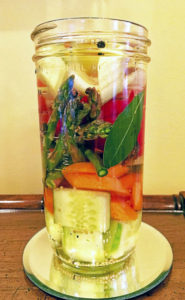ROB RABINE: Recipe — Go ahead and pickle it
By Ron Rabine – Shore Line Times
Who doesn’t like a good pickle? You kind of take them for granted until you taste a bad one.
The first time I made a batch of sour dill pickles, I had to move them out to the barn because I used a container that had a loose top and the entire house smelled like pickles for three days. It was only after we finished the pickles and I washed out the container that I noticed the bottom said, “Not safe for food storage.” I should probably get tested for lead poisoning. Live and learn. Now I use a mason jar.
Salt-based, lacto-fermented foods like pickles, sauerkraut, kimchi and the like are quite popular right now for a couple reasons: one-they are artisanal and that’s always popular, and two-because of their probiotic benefit. It’s good for your gut, so to speak.
Salt-based brines are called lacto-fermentation brines not because of any milk-based products, but because of the naturally occurring lacto-bacteria that eats sugar and makes lactic acid as a by-product, making your pickles tart.
Use any combo of vegetables you want, just keep them anaerobic, under water the whole time, and skim off any foam that collects. Filtered or distilled water helps the fermentation process. Follow me on Istagram @robert.rabine. I’m wicked interesting.
Mixed Pickled Vegetables
3 tablespoons kosher salt
1 quart filtered or distilled water
1 cup celery, sliced ½ inch thick on the bias
½ cup cucumber, peeled and sliced in half lengthwise, then cut an inch thick
½ cup carrot, peeled and sliced ½ thick on the bias
½ cup asparagus spears, trimmed and sliced ½ inch on the bias
½ cup red pepper, sliced ½ inch thick
1 clove garlic, peeled and smashed
1 bay leaf
½ teaspoon mustard seeds
¼ teaspoon whole black peppercorns
1 cabbage leaf
Combine the salt and room temperature water and stir until the salt is completely dissolved. Layer the vegetables and other ingredients in a clean mason jar, leaving about an inch of space on top. Pour enough salt water over the vegetables, pressing them down tightly with a clean spatula so they are completely submerged under the brine. Top with the cabbage leaf. Seal the jar tightly and leave out in a warm spot in the kitchen. Once a day, open the jar to let out some of the gas, and skim off and foam that collects on top. Taste the pickles after three days or so. Refrigerate after they taste sour enough for you-from 3 to 5 days. Pickles last up to a month in the refrigerator. Yield 1 quart.


